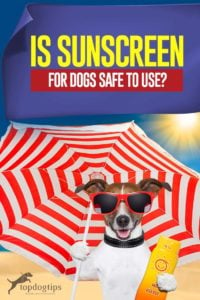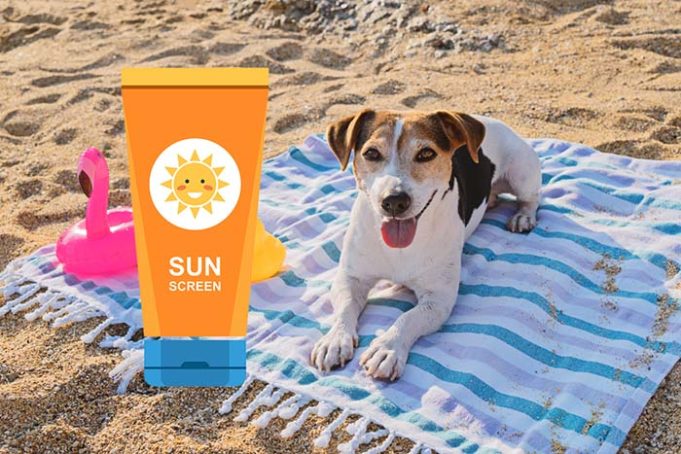It may not be the first thought for a pet owner, but dogs get sunburned too. Their skin is just as sensitive to UV rays as humans' skin is, and canines can suffer from possible complications, develop diseases and conditions associated with too much sun exposure.
Sunburn for dogs is not only painful, but it has the chance of leading to more serious problems or exacerbating old conditions. It can cause general discomfort at surgery sites, aggravate autoimmune disorders and dermatitis in dogs, and even cause skin cancer, just like in people.
ALSO SEE: 7 Best Dog Sunscreens That Are Safe and Effective
Should You Use Sunscreen?
Broad spectrum sunscreen can protect dogs from both UVA and UVB sun rays. When these rays are prevented from damaging the dog’s skin, it reduces the chances of the dog getting sunburn or developing other sun related conditions. That being said, not all sunscreens are safe for use on dogs and can increase their skin irritation with or without blocking the sun's rays.
A common ingredient used in human sunscreen is zinc oxide; it's in the normal spread-on sunscreens that most people use. Unfortunately, zinc-oxide is extremely toxic to dogs. If it is ingested, it can damage a dog’s red blood cells. When they’re affected in this manner, the cells can explode and cause severe anemia in dogs, with the possibility of causing the dog having to undergo blood transfusion.
Another ingredient to avoid in human sunscreens would be octisalate which is a salicylate. A commonly known use of salicylate is aspirin. It is okay in small amounts, just avoid any sunscreen that contains large portions on the off-change your pooch may lick it off.
A few more ingredients to avoid in sunscreens:
- Benzophenone-3
- Triethanolamine
- Methyl Paraben
- DMDM Hydantoin
- Imidurea
- PABA
All of these ingredients are toxic to dogs, with a majority of them being fatal if the animal ingests them.
What Kind Works Best?
 The best type of sunscreen for you dog are those that are specifically meant for pets, and there's a number of good dog sunscreens available. They don’t include any types of potentially toxic ingredients while also avoiding added scents. Scents are common in human sunscreen but they can be potential allergens or even toxic to dogs.
The best type of sunscreen for you dog are those that are specifically meant for pets, and there's a number of good dog sunscreens available. They don’t include any types of potentially toxic ingredients while also avoiding added scents. Scents are common in human sunscreen but they can be potential allergens or even toxic to dogs.
If there is a situation where using human sunscreen is required, try not to use adult sunscreen. Adult sunscreen is usually more dangerous if ingested by the dog, and includes more ingredients that the dog’s skin can react to negatively. Use a sunscreen meant for infants or children. These sunscreens usually have less potentially harmful ingredients and will be more gentle on your pet. Also, make sure that the sunscreen is a minimum of SPF 15.
Like with children, it is recommended that sunscreen, when used for the first time, should not be applied to the dog’s entire body until it has been tested on their skin in a small area. Watch that area for any type of allergic reaction, such as reddening or inflammation. This is important as it is better for them to experience a small allergic reaction rather than one that affects their entire body. If they do experience a reaction, try switching brands instead of giving up on pet sunscreen. It could just be a small ingredient that is not common among all sunscreens for dogs or people.
Which Dogs Need It?
Every dog has the potential to suffer from sunburn on some parts of their body, regardless of whether they have thick or thin fur, long or short, or none at all. They all benefit from using sunscreen when going outside on a bright day.
That is not to say that some don’t need it more than others, however. Dogs with lighter or white colored fur are more likely to get sunburned than those with brown or black. Also, dogs that have thin coats or are kept shaved are at a higher risk of being sunburned. This is why you shouldn't shave your dog in summer (or even, in most cases).
Dogs that spend more time out in the sun need sunscreen more frequently that dogs that do not. The same goes for dogs that have been sunburned before, they require the use of sunscreen more than dogs that have never been burned.
Where Does It Go?
There are no real limits on where to apply sunscreen, although there are suggested areas that should be covered. The best places to focus on are the dog's snout and nose, ears, lips, belly, and groin. Pay special attention to the areas where the skin is light or pink. If the dog suffers from alopecia or hair loss, make sure to cover those areas thoroughly with the dog sunscreen.
 A good and obvious rule of thumb is to cover the areas that have little to no fur, or where the fur is thinnest. There is no reason to focus on their sides where their fur is heavier and the sun doesn’t reach the dog's skin.
A good and obvious rule of thumb is to cover the areas that have little to no fur, or where the fur is thinnest. There is no reason to focus on their sides where their fur is heavier and the sun doesn’t reach the dog's skin.
When Should It Be Used?
Most dogs go outside multiple times during the day, whether to play or have a potty break. These are not necessarily the times when sunscreen should be used. Sunscreen should be used when the dog is going to spend long periods of time outdoors during the sunniest parts of the day, from 10am to 3pm. For a sensitive skin dog, this can include lying in sunny spots indoors.
Sunscreen should also be used when going on long outdoor trips. This can include long walks and hikes, boat rides, trips to the dog park, beach trips, and camping trips.
There are other ways to prevent sunburn, such as making sure they have a nice shady spot outside to escape the heat. Another method is using dog summer clothes for sun protection, such as a canine shirt or vest to protect against harmful rays without having to fully coat their belly in sunscreen. Just note that not all of them will cover every body part.
How to Know If a Dog Has Sunburn
 For dogs, red skin is not the only visual symptom of sunburn. It can also lead to hair loss in burned areas. Dogs have naturally pigmented skin so it is very important to monitor any changes in color, especially a darkening in the pink pigment. This is most noticeable on the nose where the hair is thinner and even more so for those dogs that have white fur on their snout.
For dogs, red skin is not the only visual symptom of sunburn. It can also lead to hair loss in burned areas. Dogs have naturally pigmented skin so it is very important to monitor any changes in color, especially a darkening in the pink pigment. This is most noticeable on the nose where the hair is thinner and even more so for those dogs that have white fur on their snout.
Oftentimes, the dog's skin is more sensitive than before and in comparison to other areas of the skin. It is not normally itchy and is instead painful to the touch.
READ NEXT: The Best Sun Protection Clothing for Dogs













